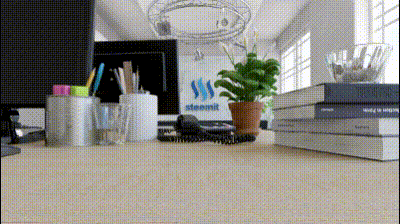AR industry
AR technology has been around for a long time now. There have been many marketing campaigns involving scannable QR codes, which would trigger a small 3D object or an animation pop-up. It was used mostly to augment the functionality of brochures and posters. I personally also had a chance to work on such projects, one of the more notable ones involving Maserati's launch campaign of their new SUV car.
Sadly, the technology wasn't perfect. Depending on the tracker (the image you're scanning) the object would shake and wobble around. Also, as soon as you moved the tracker out of the camera's field of view, the object would disappear. QR codes proved to be best trackers, but often didn't fit into the marketing material's design. Clients would often prefer a solution that involved tracking an image, but it was always up to the image sophistication and contrast, that would offer decently stable tracking - most of the designs did not work too well.
I decided to record a short clip as a demonstration of the old VR tracking technology. The following is a recording of EON's Creator AVR app, using a good quality QR code as tracker. Even with a quality tracker, it is fairly easy to demonstate the issues described above:
ARKit - the game changer
Apple's WWDC reveal of its brand new Augmented Reality technology, the ARKit has shown off the true potential of the AR industry. When I first saw the event video on-line, the ARKit demonstration looked almost unreal (well, it was build in Unreal Engine 4, but no pun intended). The object was perfectly stable and the app let you freely walk around the display table without losing track at all!

I was ready to jump aboard the hype train, once again. As soon as it was available, I downloaded the Unity ARKit plugin and got to work:
ARKit - the technology
Unlike the previous AR technology which uses image recognition to anchor an object, ARKit scans entire surfaces and finds bunch of points in the envinronment to pin down a 3D objects in space. The result is mind-boggling! Surface scanning is indicated by a blue box, once it aligns with your desired surface, tap on the screen and the objects snaps right in place.
Scanning
ARKit scanning isn't as straight forward as its predecessor. Previously, with tracker AR technology, the 3D object would instantly snap on the tracker, once it was in camera's view. ARKit recognizes surfaces and you'd have to walk around your room for a while, picking up different surfaces and edges before you can place the object accurately. The application scans virtually any surface, with the sole exception of a highly reflective glass table at the office.
Stability
Once scanned, the object would neither wobble nor shake. It would only start "drifting away" once you get too close to the table, thus not providing the application with enough environment reference. I would even go on and try to "confuse" the application, by moving the iPad rapidly. This would only give the object a bit of an offset and would almost unnoticeably snap back to original position once the scanned surface was in view
Hardware
Having had tested numerous different models and scenarios (some of them involving high poly architectural buildings), I can say the technology is rather light on performance. One of the problems, however, is the fact that ARKit requires the new iOS11, which might discourage some of the older iphone/ipad users.
ARKit - the impact
While it's hard to say how exactly ARKit will position itself in the AR market, its tracking ease, stability and availability (all iOS11 users) will definitely bring AR closer to mass adoption. More and more ARKit-based game are being introduced on the app store, some of better ones include Lego AR, Smash Tanks or Stack AR.
I was not surprised to learn Android quickly followed the trend by introducing its own version of surface scanning AR solution called the ARCore. The ARCore currently works with the newest Android devices, but unfortunately, there isn't much content to test it on as of today.
The on-going event, CES2018, is a perfect example of the increasing interest and focus on VR and AR technology. Hopes are high, as MagicLeaps (a super secretive, 2bn dollar AR project) announced of their very first commercial headset version coming later this year.
Will AR overshadow VR? Will AR ever be mass adopted? Let me know what you think down below!

If you're interested in finding out more about emerging technologies, CGI work and VR reviews, follow me and drop a comment below!
▶️ DTube
▶️ IPFS


